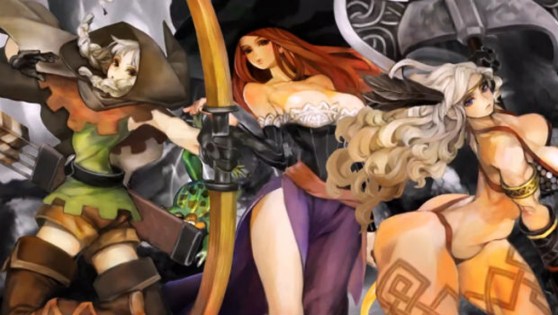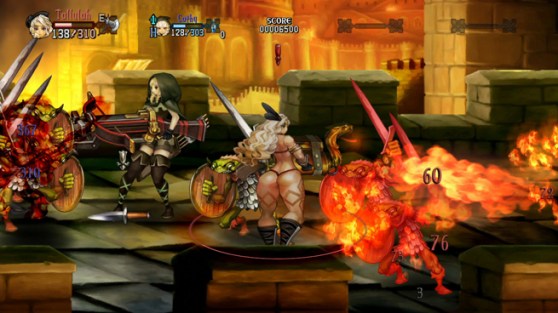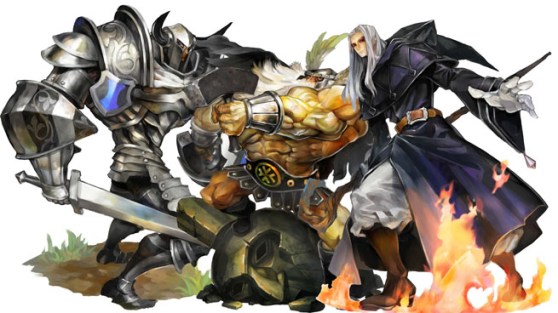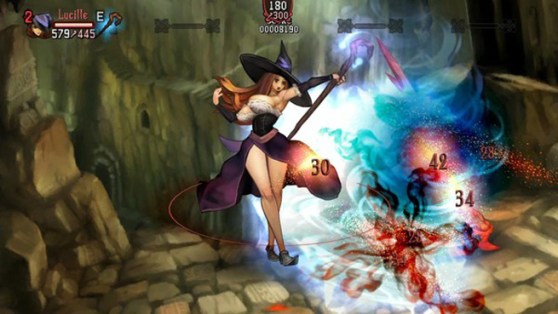Kamitani is a highly gifted artist. He makes beautiful games, and Dragon’s Crown is no exception. The man knows what he’s doing.
And he consciously filled this game with blatant sex objects.
Take the Sorceress’ spine-destroying rack and how it jiggles with every move she makes, major or minor. Sometimes, her colossal, physics-defying breasts whipped around so fast I expected them to break her collarbone. I actually spent more time with the Amazon, and while it’s very difficult to offend or shock me with cheap slap-and-tickle, I did start to feel like someone was insulting my intelligence.
For starters, she walks with a hip-dislocating gait designed solely so she can flash her G-stringed ass at the player with every other step. When riding a mount, the Amazon leans back so heavily, I have to figure she’s trying to shift weight off her ample chest. When downed, the Amazon drops on all fours, moaning, in a pose better associated with a hastily made reality-star sex tape. I’m not even joking.
At one point, I wondered to myself, “Does this game want me to fuck it? Because I really don’t want to. It’s not my type.”
No, you don’t have to play as those characters, but the fan service doesn’t stop there. Menu screens feature your fairy girl lounging in a goblet, holding a cherry, and leering at you drunkenly. Still-image cutscenes star women stretched out on sofas wearing see-through dresses.
Now, I hasten to point out that Dragon’s Crown isn’t a parody or a satire — the natural companion of exaggeration. It makes no commentary. This is an homage. It takes itself seriously even though it’s impossible for anyone else to take it seriously. So why do it? Why go in this seemingly exploitative direction?
I put the question to Sammy Matsushima, the project lead for publisher Atlus USA. “It’s not about sexuality,” said Matsushima. “It’s more about exaggeration of fantasy art. This kind of artwork’s been seen in Frank Frazetta-type fantasy art. It’s nothing new.”
Not precisely. Artists like Frazetta and Boris Vallejo painted ridiculously idealized men and women. The style Kamitani chose, for me, veers strongly into the grotesque. I mean that in its literal sense: fanciful human or animal forms distorted into absurdity, ugliness, or caricature. Dragon’s Crown practically demands that I be turned on by these women, and it hard-sells the titillation at every possible turn. I was not titillated. I even felt mildly resentful that it presumed I’d react like a big, dumb guy because I saw big, dumb boobs flopping around.
And that’s the exactly wrong reaction you want someone to have toward a game.
That won’t be everyone’s response. In fairness, Kamitani bent the male characters into funny shapes, too. The Knight looks like a giant silver bullet, the Dwarf is a comical short-stack of muscle, and I caught a wizard named Lucain who’s exactly one lawsuit away from being Gandalf the Grey. A lot of love went into this. Atlus USA, to its credit, chose to back Kamitani up.
“We see his vision, we share his vision, and I don’t think that should be taken away,” says Matsushima. “We’re not going to shy away from it. We should not hide.”
True enough. But while you might find a good game somewhere deep inside Dragon’s Crown, the obstructions are already reason enough for me to give it a miss. The single-player mode feels too lonely, multiplayer too busy, and like Postal 2, I’d feel too much like a drooling idiot if I actually liked what it’s showing me … despite its otherwise outstanding visuals.
“The game is what it is,” as Matsushima says. Odds are you already know if that’s something you want.
VentureBeat's mission is to be a digital town square for technical decision-makers to gain knowledge about transformative enterprise technology and transact. Learn More




